

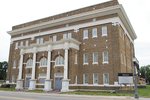
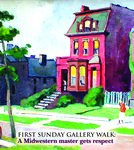
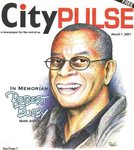



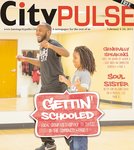
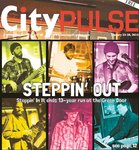

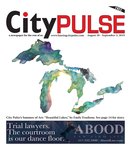
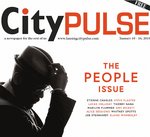

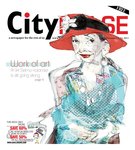

When we discussed this special 20th anniversary issue, I was given the difficult assignment of crafting an easily digestible retrospective of the major cultural developments in Lansing that have been covered by City Pulse. Obviously, it would be impossible to include absolutely everything, but I began to rack my mind for the things that really mattered.
As I began my research, flipping through the thousands of newspaper pages City Pulse has produced in the past two decades, I realized what a brilliant time capsule this publication truly is. I am only 26, the stories form a timeline and narrative that run parallel to my own memories of growing up here in Mid-Michigan.
I can flip to any of the weekly issues published in the past 20 years and figure out what exactly was happening in Greater Lansing at the time. Whether it’s through the many features on local indie rock bands that seemed poised to one day take over the Billboard charts, or in-depth reports on developments that signaled major sea changes, such as the construction of the Broad Art Museum, the pages of City Pulse are a definitive modern chronology for the culture of Michigan’s capital city.
2001-2006
City Pulse’s basic weekly formula hasn’t deviated much since its inception – if it isn’t broke, why fix it? The debut issue of City Pulse pledged that Lansing’s cultural world was going to be a major focus of its coverage. The first article ever published in the Arts & Entertainment section provided a crash course on the different venues, art galleries and music scenes that were operating within the city, declaring that “the Lansing arts scene is alive and well.”
Coverage of local theater began with an introductory profile on Tom Helma, who continues to write critiques and rate productions for City Pulse to this day. Also making its first appearance was Out on the Town, City Pulse’s events calendar that has run weekly ever since. And just a few issues later, Lawrence Cosentino would write his first symphony review, marking the arrival of City Pulse’s most acclaimed writer.
An early City Pulse cover story previewed the Temple Club in Old Town, which opened its doors in October 2001 and hosted concerts by groups such as Wu-Tang Clan and Clutch. It was a cornerstone of the Lansing music scene, and articles about its concerts regularly popped up in City Pulse until its ultimate closure in 2006 due to financial troubles. The Temple Club is now a pleasant but increasingly distant memory. The old church, which has sat empty since the club closed, is being renovated into residences.
Another blast from the past is the October 2001 cover story that explored the local book shop scene. Prominently featured was an interior shot of the old Barnes & Noble on Grand River Avenue. East Lansing’s two-story chapter of the retail giant closed its doors in 2011 and was likely the biggest book store to shutdown until Schuler Books left the Eastwood Towne Center in 2018.
Old City Pulse issues had a prominent monthly feature called the 1st Sunday Gallery Walk, which was a nifty guide that painstakingly detailed every single gallery event you could come across in town. Thumbing through old editions of the 1st Sunday Gallery Walk and you’ll see all sorts of art venues that came and went without warning, such as the Art Apartment in East Lansing, the subject of several early City Pulse stories that ultimately closed for good in December 2002.
A year into City Pulse’s life, a dubious competitor arose. Not too long after celebrating its 1st anniversary, publisher Berl Schwartz warned readers of the advent of NOISE, a faux alt-weekly published by Gannett that was circulated in Lansing and Boise, Idaho. City Pulse ultimately came out on top of the rivalry: NOISE went quiet in 2011.
A particularly hilarious highlight from this era of City Pulse comes from Lawrence Cosentino, who lambasted the cheesy and obnoxious lounge music being blared downtown at the time. To this day, the music perforating the air of downtown Lansing receives flak. Although nowadays we suffer bland Top 40 hits that are often five years out of style, Cosentino was still ahead of the curve on tapping into what annoys the good people of Lansing.
This early-’00s period were also the golden era for concerts at the Michigan State University Ballroom, all of which are chronicled in the pages of City Pulse. Early Arts & Entertainment reporters were deftly plugged into the local music scene and didn’t miss a beat on gigs that are now legendary. This includes the White Stripes, who performed at the MSU Union in 2002 before their meteoric rise in popularity. Other acts that swung through the Union at the time and were covered by City Pulse include Talib Kweli and Death Cab for Cutie. Small Brown Bike, a now nationally recognized and celebrated indie rock, also received a nod from City Pulse as it played its final gig in 2004.
Of note throughout the first five years of City Pulse was the birth of its extensive coverage of festivals. In-depth reports on the artists and performances of Lansing JazzFest, East Lansing Film Festival, East Lansing Art Festival and Old Town BluesFest are longstanding traditions — each have been profiled with great care on a yearly basis since City Pulse’s inception. City Pulse also took notice of just about every prominent festival in town, keeping up with its original goal to make local arts a staple of the paper’s coverage and not just an afterthought. If a festival wasn’t included in “Out on the Town” or in the Arts & Entertainment section, it likely didn’t even exist.
Making national headlines was the removal of “This Equals That,” a stunning public art sculpture designed by Michael Heizer, from the west plaza of the State Capitol Building. City Pulse articles from 2002 speculated on the fate of the sculpture and whether it would return in some capacity.
Other early stories that still permeate Lansing’s culture to this day include the construction of Ranney Skate Park, Timothy Muffitt’s hire at the Lansing Symphony Orchestra, the opening of the Hannah Community Center, the debut of Scene Metrospace in East Lansing, the arrival of Michael Brand at the Wharton Center (who has announced his retirement this year) and a cover story that seemingly predicted the REO Town neighborhood’s eventual return to prominence.
All of this goes without even mentioning the countless reviews of local theater productions. City Pulse likely covered all but a few plays that hit the stage in Greater Lansing. City Pulse also debuted its Pulsar Awards, which honor the best of the best in local theater annually.
2007-2012
The Lansing art scene was dealt a profoundly shocking tragedy early on in 2007. Local legend Robert Busby, loved by many and known as the “Mayor of Old Town,” was murdered by a tenant of one of his properties. A candlelight vigil in his honor was attended by several hundred. He was 60.
Common Ground Music Festival, at the time still a seven-day event, was in its heyday during this era of City Pulse. But a report by journalist Steve Miller that criticized the lack of transparency surrounding the city’s funding of Common Ground seemed to sour relations between City Pulse and the concert’s organizers. Back in the day, Common Ground was criticized for featuring dinosaur classic rock acts, and nowadays it’s mocked for featuring too many contemporary rappers. You really can’t win sometimes.
Dominating the pages of City Pulse’s Arts & Entertainment section was news about an $11 million expansion for the Wharton Center and talk of an amphitheater for Adado Riverfront Park coming out of City Hall. That amphitheater has yet to materialize. The old Lansing City Market was closed to make way for its giant metal pole barn replacement — a highly controversial issue that was debated endlessly. That old market is gone and the new one sits empty as it awaits its shuffleboard makeover. Did either side get what they want? Not likely.
The weekly feature Turn It Down debuted in 2009 and music writer Rich Tupica has since kept a close watch on the Lansing music scene. It quickly became the go-to field guide for local concerts and handy resource for discovering who’s who on the local concert circuit. Tupica also used the feature to interview local artists and report on how independent Lansing music was growing and changing through the years.
The expansion of the Lansing Public Media Center allowed City Pulse to debut its “Newsmakers” program, a television show where Berl Schwartz would interview prominent local political figures like Virg Bernero. While that program has since ended, Schwartz conducted a similar series of interviews with Mayor Andy Schor and occasionally does video interviews on Lansingcitypulse.com
City Pulse launched the Top of the Town contest, where voters decide on their favorite people, places and things across Lansing. It didn’t take long for Top of the Town to become a hit, and it is still a prominent event for City Pulse several years later.
Lansing theater lost a highly prominent institution when BoarsHead shuttered in 2010. Financial problems and prominent personnel mix-ups proved too great for the company to endure. BoarsHead was formed all the way back in 1966, and its productions were a common sight in the pages of City Pulse from the very beginning. Unfortunately, this touch of bad luck continued for Lansing theater fans. In late 2010, community theater was dealt another blow as the Lansing Civic Players – Lansing’s oldest amateur theater group, formed in 1929 – canceled the remainder of its season, foreshadowing the numerous financial issues that would plague the troupe until it ultimately reached its current state of dormancy.
But the biggest story in Lansing culture was undoubtedly the advent of the MSU Broad Art Museum, and City Pulse covered it every step of the way. Readers were given reports surrounding the new museum, from stories on early rumors and mysteries all the way up to the announcement of Zaha Hadid as its architect and its eventual grand unveiling.
East Lansing initially seemed split on the Broad. Some criticized its design as being way too out of place for MSU’s campus, while others praised it as a bold step that would attract global attention. Controversy continued to follow the museum as it seemed to walk back on its promise to feature pieces from the mammoth sized Kresge art collection. Reception of the museum has since warmed up and it has hosted several breathtaking exhibits, many of which earned City Pulse cover stories of their own. Its current director, Mónica Ramírez-Montagut, was profiled by Cosentino in 2020.
Other big stories in City Pulse through this period included the debut of the Capital City Film Festival, the opening of the Record Lounge, Gone Wired becoming the Avenue Café, the expansion of the Lansing Public Media Center, the closing of Community Newscenter and Capital Books, local author Deborah Diesen becoming a New York Times best-selling author, the B414 concert venue shutting down and the scandal surrounding the rather dubious owner of Zeppelin’s Music Hall.
2013-2018
With its ten-year anniversary in the rear-view mirror, City Pulse had accomplished a major milestone. It survived competition from Gannett in the form of its faux alt-weekly NOISE and became the definitive local guide for theater as play reviews began to evaporate from the Lansing State Journal.
Local legends Steppin’ in It were the subject of a January 2014 cover story detailing the band’s retirement with one last gig at the Green Door. Its members continue to have prominent music careers, with Joshua Davis becoming a popular singer/songwriter and Dominic Davis finding work as Jack White’s go-to bassist.
“Kinky Boots” arrived at the Wharton Center, and several local figures donned the titular kinky boots. Even publisher Berl Schwartz gave ‘em a try — with fabulous results, we might add. City Pulse also debuted the first Summer of Art, a partnership with the Arts Council of Greater Lansing that called for local artists to submit work to potentially be featured on the cover. It became a yearly tradition until it was interrupted by the coronavirus pandemic in 2020. The People Issue also made its debut, giving readers the opportunity to learn about some of the unsung heroes of their community.
Casa de Rosado began hosting art exhibits that celebrated artists from minority backgrounds that were otherwise ignored by the mainstream. Its founder, Theresa Rosado, would eventually contribute photography to City Pulse, including a powerful photo essay from the day white nationalist Richard Spencer came to MSU’s campus. Terry Terry’s UrbanBeat venue opened in Old Town, featuring acoustic singer-songwriters and jazz combos. Nanibah Chacon’s mural near Sir Pizza was instantly iconic.
George Howard, a 92-year-old jazz artist who was the subject of a cover story after he recorded his first album. The story behind the album, titled “How It’s Done,” was a touching tale of determination that highlighted how brilliant of a writer Cosentino had blossomed into. Another popular cover story was on arts philanthropist Selma Hollander when she was 94; she passed away seven years later, at 101. Cosentino also profiled the new MSU Museum director Mark Auslander, who later found himself in hot water after pulling the plug on the Great Lakes Folk Festival. Auslander would again become the subject of controversy and resigned in 2020 after being found guilty of research misconduct and plagiarism by the MSU Research Integrity Office.
New institutions to the local art scene included the Broad Art Lab, a satellite extension to the Broad Museum that hosts hands-on art demonstrations and exhibitions featuring works by local artists, as well as pieces taken from the monumental Kresge art collection. The Arts Council of Greater Lansing debuted ArtPath, which beautified the Lansing River Trail with a walkable outdoor exhibit of stunning works from Michigan-based artists. Ozay Moore and Dustin Hunt would also debut the Below the Stacks mural festival, which spawned the creation of some of Lansing’s latest and greatest murals.
Present
The Lansing art world is still recovering from the devastation of the coronavirus pandemic. For more than a year there was no live, in-person music, there were no festivals and there were no art exhibits. Anything that survived and carried on, was only able to do so thanks to livestreaming technology. And for those who are immunocompromised and still must stay sheltered away from public gatherings, this is still the case.
If there is anything to take away from revisiting the world of Lansing’s arts and culture scene of the last 20 years through the wide lens of City Pulse, is that there is a lot to love and even more to lose. While its great to enjoy art vicariously through features, profiles and reports, it pales in comparison to going out there and experiencing it for yourself. At the risk of being grossly sentimental, I truly hope this look back gives you a sense of appreciation for your city. Or at the very least, a nice nostalgic grin across your face.
Support City Pulse - Donate Today!
Comments
No comments on this item Please log in to comment by clicking here